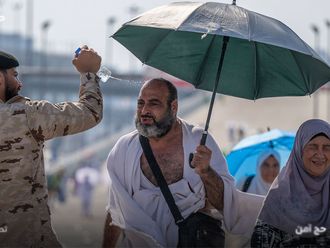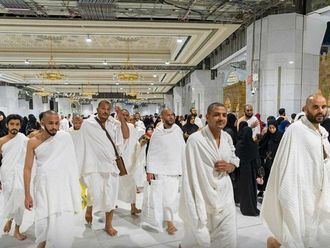
CAIRO: US Secretary of State Antony Blinken blamed Hamas on Monday for holding up a ceasefire in Gaza, as the top US diplomat conducted a Middle East peace mission to deliver President Joe Biden’s latest proposed plan to end the Gaza war.
Speaking after meeting Egyptian President Abdul Fattah Al Sissi in Cairo, Blinken said Hamas was the only side that had yet to agree to Biden’s proposal, which Washington says already had Israel’s backing before Biden announced it on May 31.
Washington says its proposal envisions a ceasefire in stages, ultimately leading to a permanent end to the war. But Israel still says it will agree only to temporary pauses until Hamas is defeated, while Hamas says it will not accept a truce without guarantees that the war will end.
“My message to governments throughout the region, to people throughout the region, is - if you want a ceasefire, press Hamas to say ‘yes’,” Blinken told reporters before departing Egypt to visit Israel where he was due to meet Prime Minister Benjamin Netanyahu.
Also read
“If you want to alleviate the terrible suffering of Palestinians in Gaza, press Hamas to say ‘yes’. If you want to get all the hostages home, press Hamas to say ‘yes’. If you want to put Israelis and Palestinians alike on the path to more durable peace and security, press Hamas to say ‘yes’,” he said.
Senior Hamas official Sami Abu Zuhri told Reuters Blinken’s comments were “an example of bias toward Israel and it offers American cover to the holocaust conducted by the occupation in Gaza”.
Ahead of Blinken’s trip, Israel and Hamas both doubled down on hardline positions that have scuppered all previous attempts to end the fighting, while Israel has pressed on with assaults in central and southern Gaza, among the bloodiest of the war.
“We are committed to total victory,” Netanyahu said in a statement released by his office, quoting remarks he made on Sunday to relatives of Israelis killed in Gaza. He said he would reject a Hamas demand to “commit to stopping the war without achieving our goals of eliminating Hamas”.
Hamas and its allies Islamic Jihad said in a joint statement: “Any agreement must ensure a permanent end to the aggression and a complete withdrawal from the Gaza Strip, reconstruction, lifting the blockade and a serious swap deal.” The war has now entered its ninth month, since Hamas-led fighters killed 1,200 people and took some 250 others hostage in a rampage through southern Israel. Israel’s assault on the Gaza Strip has killed more than 37,000 Palestinians and reduced most of the enclave to wasteland.
Palestinian officials said 40 more bodies arrived in hospitals over the past 24 hours, and thousands more dead are believed buried under rubble.
ASSAULTS IN RAFAH, NUSEIRAT
In Rafah, the city on the southern edge of Gaza where Israel launched an offensive last month, residents said on Monday tanks had been thrusting deeper towards the north in the early hours of the morning. They were on the edge of Shaboura, one of the most densely populated neighborhoods at the heart of the city.
Around half of the Gaza Strip’s 2.3 million people had been sheltering in Rafah before last month’s assault, and a million have since fled again.
Since last week, Israel has also launched a large assault in the central Gaza Strip, around the small city of Deir al-Balah, the last population centre yet to be stormed. On Monday, residents said the Israelis had pulled back from some areas there but were keeping up air strikes and shelling.
Residents in Nuseirat, north of Deir Al Balah, were still clearing debris after Israel freed four hostages in a massive raid there on Saturday. Palestinian officials say 274 people were killed, making it one of the deadliest assaults of the war.
Israeli forces said they were aware of under 100 Palestinians killed there and did not know how many were combatants.
“We are exhausted and helpless, enough is enough,” said Jehad, who fled under fire from Saturday’s assault in Nuseirat with his family and was now in Deir Al Balah, speaking by text message. The family had already been displaced from Gaza City to Nuseirat, to Khan Younis, to Rafah and back to Nuseirat before their latest flight.
In video obtained by Reuters from Nuseirat, resident Anas Alyan, standing outside the ruins of his home, described how Israel commandos wearing shorts had appeared in the streets, firing wildly while F-16s and quadcopters fired from the air.
“Anyone moving in the street was killed - anyone moving, or walking, was killed immediately,” he said. “There are still children under this building. We don’t know how to pull them out,” he said, pointing to one ruin. “Today we found children martyred in that building,” he said, pointing to another.
After months of failed peace efforts, Biden chose a new tack with his public announcement on May 31 of a ceasefire proposal.
US officials say Biden unveiled it without asking the Israelis first, to increase pressure for a deal.
The United Nations Security Council will vote later on Monday on a US-drafted resolution backing Biden’s proposal.
Full details of the proposal have not been publicly disclosed but, as described by US officials, it is similar to texts floated in previous failed peace efforts: a long truce over several stages, with gradual release of Israeli hostages ultimately leading to an end to the war.
What is different this time is that Israeli forces have now stormed most territory inside Gaza at least once, and Netanyahu is under greater domestic political pressure to reach a deal.
Benny Gantz, a popular centrist former military chief, quit Israel’s war cabinet on Sunday over what he described as the failure to outline a plan for the war’s end. That leaves Netanyahu more reliant on far-right allies who threaten to bring down his government if he agrees a deal leaving Hamas unvanquished.












